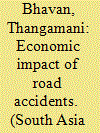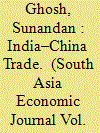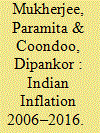|
|
|
Sort Order |
|
|
|
Items / Page
|
|
|
|
|
|
|
| Srl | Item |
| 1 |
ID:
165371


|
|
|
|
|
| Summary/Abstract |
The purpose of this study is to disclose accident-related indices and investigate the extent to which the road accidents impact on the economic performance of Sri Lanka during the period from 1977 to 2016. Annual time-series data are used to evaluate the accident indices for econometric analysis. Augmented Dickey–Fuller (ADF) unit root analysis and Johansen’s maximum likelihood estimator of the parameters of a cointegrating vector error correction model (VECM) are employed to test the stationary properties of the time series and to examine the long-run relationship between the variables, respectively. The results derived from the analysis confirm the existence of long-run relationship between the accident-related indices and macroeconomic indicators. The long-run elasticity values imply the signs and magnitude of impact of the accident indices on macroeconomic indicators.
|
|
|
|
|
|
|
|
|
|
|
|
|
|
|
|
| 2 |
ID:
165368


|
|
|
|
|
| Summary/Abstract |
This article seeks to provide an overview of the evolution and analyses the changing composition of trade between India and China over the period 1983–2017. We find that Chinese exports are almost completely concentrated in manufactures, especially finished equipment goods, whereas Indian exports consist of both agriculture and manufactures and over time have shifted predominantly to intermediate goods. Further, both the countries are exporting those commodities to each other in which they have a revealed comparative advantage, with China’s exports being more diversified. We employ vector error correction estimation and show that China’s exports to India are dependent on India’s household consumption expenditure, while India’ exports to China are correlated to Chinese manufacturing value added. Finally, we calculate the share of each country’s commodity-wise export to the partner in their respective total exports with a view to studying prospects for India–China trade. We conclude that for further trade expansion, diversification is extremely necessary, and Indian exports of inputs to Chinese industries need to change substantially to accommodate the changing nature of China’s industrial structure.
|
|
|
|
|
|
|
|
|
|
|
|
|
|
|
|
| 3 |
ID:
165367


|
|
|
|
|
| Summary/Abstract |
Recently several changes have been adopted in the conduct of monetary policy in India, like tracking CPI (Consumer Price Index), targeting inflation and so on. However, certain curious features of inflation may have some implications on the effectiveness of such measures. This article tries to explore the nature of inflation during the last decade. There are certain views about the nature of Indian inflation from the structuralist perspective. This article contributes to the literature by empirically testing those propositions and coming out with some significant policy implications. The article is based on monthly data from January 2006 to March 2016. By employing econometric techniques like cointegration and vector autoregression (VAR), the article tries to explain the movements of different components of WPI (Wholesale Price Index) and CPI inflation, both core and headline inflation and how they are related to macroeconomic policy variables. The empirical analyses focus on finding out the existence of co-movements among the inflation and macroeconomic variables, explaining the role of components like food and fuel price in driving CPI and WPI. The results have some important policy implications. First, the movements of WPI and CPI and their headline and core counterparts are not explained by same set of variables. Second, food inflation is not explained by agricultural output pointing to the insufficient increase in supply in agriculture. Third, the determinants of CPI headline and core inflation are not same. So, both of them should be tracked while formulating policies. The relationship among the components of inflation point to the possibility of some adjustment in demand from one set of goods to another, implying adjustments in terms of relative prices which needs further exploration.
|
|
|
|
|
|
|
|
|
|
|
|
|
|
|
|
| 4 |
ID:
165366


|
|
|
|
|
| Summary/Abstract |
During the last decade, Bangladesh economy grew consistently over 6 per cent annually; however, growth rate in the agriculture sector declined. Labour away from agriculture is evident; it is also evident real wages in the agriculture sector are rising. This could be an indication that Bangladesh is moving to a different stage of economic development. This article investigates whether Bangladesh is approaching a stage of economic development where marginal productivity of labour equals its price, called the Lewis turning point (LTP). We find that the reallocation of labour away from agriculture has had a positive but insignificant impact on economic growth in Bangladesh. We also find that the surplus agricultural labour has not fully been absorbed by the economy. Therefore, we conclude Bangladesh has yet to reach the LTP and suggest initiating policies (e.g., job creation in the service sector) that might speed up the country’s movement to the LTP.
|
|
|
|
|
|
|
|
|
|
|
|
|
|
|
|
| 5 |
ID:
165370


|
|
|
|
|
| Summary/Abstract |
This article undertakes an examination of Bangladesh’s latest available Quarterly Labour Force Survey 2015–2016 data to draw in-depth insights on gender wage gap and wage discrimination in Bangladesh labour market. The mean wage decomposition shows that on average a woman in Bangladesh earns 12.2 per cent lower wage than a man, and about half of the wage gap can be explained by labour market discrimination against women. Quantile counterfactual decomposition shows that women are subject to higher wage penalty at the lower deciles of the wage distribution with the wage gap varying between 8.3 per cent and 19.4 per cent at different deciles. We have found that at lower deciles, a significant part of the gender wage gap is on account of the relatively larger presence of informal employment. Conditional quantile estimates further reveal that formally employed female workers earn higher wage than their male counterparts at the first decile but suffer from wage penalty at the top deciles.
|
|
|
|
|
|
|
|
|
|
|
|
|
|
|
|
| 6 |
ID:
165369


|
|
|
|
|
| Summary/Abstract |
In order to understand the dynamics of unemployment in Bhutan at a macro-level, this study has explored the association among economic growth, inflation and unemployment from 1998 to 2016. The autoregressive distributed lag (ARDL) model was applied to estimate the impact of economic growth and inflation on unemployment. The results of this empirical analysis suggest that economic growth had no impact on the reduction of unemployment rate in Bhutan both in the short and in the long run. In fact, as the economic growth increased, so did the unemployment rate. However, inflation had a negative association with unemployment rate in the short run and a positive association in the long run. In other words, an increase in the employment rate led to an increase in the inflation in the short run. Likewise, if inflation is not monitored or controlled, the uncertainty of inflation can lead to lower investment and lower economic growth, thereby causing unemployment to rise in the long run. This study, therefore, recommends policymakers to take into account the employment elasticity with respect to economic output and focus on sectors, which have more absorptive capacity in engaging the young labour market entrants.
|
|
|
|
|
|
|
|
|
|
|
|
|
|
|
|
| 7 |
ID:
165372


|
|
|
|
|
| Summary/Abstract |
The present study endeavours to observe the trade creation and trade diversion effects of three free trade agreements (FTAs) in Asia, namely, India–Japan CEPA (IJCEPA), India–Sri Lanka FTA (ISFTA), and India–Bhutan FTA (IBFTA). The article aims to evaluate three uncommon FTAs that include developing–developed, developing–developing and developing–least developed countries. The objective is to evaluate the effects of these FTAs on exports and draw lessons for both the contracting parties and for other economies to commence FTAs that promote trade liberalization. This paper also aims to debunk the myth that FTAs between developing-least developed countries is not beneficial for the developing or least developed counterpart. The study applies augmented gravity model to capture the trade creation and trade diversion effects. The results confirm that ISFTA and IBFTA have trade creation effect, while in case of IJCEPA, there is trade diversion. These bilateral agreements can open the ways for multilateral trade liberalization in the long-run.
|
|
|
|
|
|
|
|
|
|
|
|
|
|
|
|
| 8 |
ID:
165365


|
|
|
|
|
| Summary/Abstract |
This article aims to examine the trade effects of the South Asian Free Trade Agreement (SAFTA) with a focus on Sri Lanka, by applying a gravity trade model. The study targets the following three FTAs: the SAFTA, the India–Sri Lanka Free Trade Agreement (ISFTA), and the Pakistan–Sri Lanka Free Trade Agreement (PSFTA). The outcomes of the gravity trade model estimation suggested that the trade creation effects were identified in the ISFTA, while those were not verified in the SAFTA and that the PSFTA had the trade creation effects only on the Sri Lankan imports. Those results seem to reflect the differentials in the preferential tariff rates. In particular, ISFTA could have the predominant positive effects on Sri Lankan trade flows due to its lowest preferential tariff rates, and thus the SAFTA effect might be crowded out at the current stage of Sri Lankan trade.
|
|
|
|
|
|
|
|
|
|
|
|
|
|
|
|
|
|
|
|
|